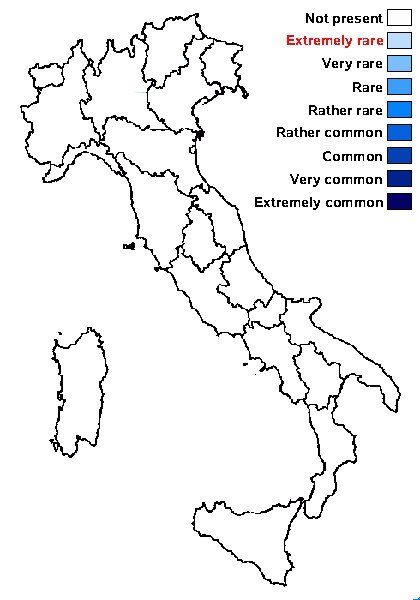Allopyrenis grumulifera (Nyl.) M. Schultz & M. Prieto
in Prieto & al., Studies in Mycology, 109: 632, 2024. Basionym: Pyrenopsis grumulifera Nyl. - Lich. Scand.: 26, 1861
Synonyms: Pyrenopsis grumulifera Nyl.; Pyrenopsis multispora Coppins
Distribution:
Description: Thallus crustose, episubstratic, dark reddish black to black when dry, dark reddish brown when wet, 50-200 µm thick, granular and effuse to cracked-areolate, homoiomerous, ecorticate, the hyphae forming a dense network around the cyanobiont cells, which are often attacked by finger-like fungal haustoria. Apothecia lecanorine, immersed, appearing perithecioid, 0.1-0.2(-0.5) mm across, with a punctiform, blackish brown disc, the ascogones formed beneath pycnidia (pycnoascocarps). Proper exciple lacking or very poorly developed, to c. 5 µm wide (thicker in upper part), pale brown to colourless in lower part, grey-brown in upper part; epithecium grey-brown; hymenium colourless, 70-80 µm high, I+ deep blue; paraphyses sparingly branched and anastomosing, 1-1.5 µm thick; hypothecium colourless, 40-50 µm high, I+ blue. Asci (8-)64-spored, unitunicate-rostrate, with a distinct K/I+ blue apical dome and a distinct outer gelatinous cap, 40-55 x 15-20 µm. Ascospores 1-celled, hyaline , oblong-ellipsoid, 4.5-7(-8) x 2-3 µm, Pycnidia unknown. Photobiont cyanobacterial, chroococcoid, the cells single or paired, 10-15(-29) µm wide, surrounded by a reddish-violet gelatinous sheath. Spot tests: all negative. Chemistry: without lichen substances.
Note: on moist siliceous rocks (e.g. schists), widespread in NW Europe and apparently rare in the Alps, with a few records outside the Italian territory (Austria, Switzerland), but likely to be undercollected. To be looked for in Italy.
Growth form: Crustose
Substrata: rocks
Photobiont: cyanobacteria, coccaceous (e.g. Gloeocapsa)
Reproductive strategy: mainly sexual

Predictive model

Source: Prieto M., Wedin M., Schultz M. 2024. Phylogeny, evolution and a re-classification of the Lichinomycetes. Studies in Mycology, 109: 595-655. - CC BY-NC-ND
Allopyrenis grumulifera, thallus very thin, granulose, apothecia very small with discs remaining punctiform (Prieto SL39). Scale bar: 0.5 mm

Photo uploaded by Paul Cannon – CC BY-NC – Source: https://fungi.myspecies.info/taxonomy/term/8407/media
UK

Source: Prieto M., Wedin M., Schultz M. 2024. Phylogeny, evolution and a re-classification of the Lichinomycetes. Studies in Mycology, 109: 595-655. - CC BY-NC-ND
Allopyrenis grumulifera, lecanorine apothecium lacking proper exciple,
clavate asci with distinct gelatinous cap and apical thickening in KOH/Lugol (Malmgren, H-NYL42947, holotype). Scale bar: 10 µm.
Growth form: Crustose
Substrata: rocks
Photobiont: cyanobacteria, coccaceous (e.g. Gloeocapsa)
Reproductive strategy: mainly sexual

Predictive model

Source: Prieto M., Wedin M., Schultz M. 2024. Phylogeny, evolution and a re-classification of the Lichinomycetes. Studies in Mycology, 109: 595-655. - CC BY-NC-ND
Allopyrenis grumulifera, thallus very thin, granulose, apothecia very small with discs remaining punctiform (Prieto SL39). Scale bar: 0.5 mm

Photo uploaded by Paul Cannon – CC BY-NC – Source: https://fungi.myspecies.info/taxonomy/term/8407/media
UK


